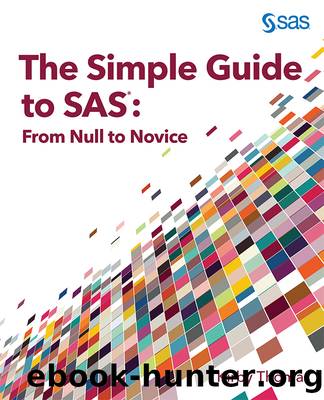The Simple Guide to SAS®: From Null to Novice (for True Epub) by Kirby Thomas

Author:Kirby Thomas
Language: eng
Format: epub
Publisher: SAS Institute Inc.
Country
City
Miles
Transportation
Usa
Philadelphia
4,117
Fly
Usa
Boston
3,837
Fly
Germany
Munich
1
Walk
Germany
Berlin
363
Drive
Kyrgyzstan
Bishkek
4,200
Fly
Italy
Rome
587
Drive
Austria
Vienna
270
Drive
Remember that you can use all the operators listed in the Filtering section above when creating your conditional logic rules.
6.5 Manipulating Values
SAS has hundreds of functions that enable you to perform calculations on numeric and date values or manipulate character values11. When appropriate, functions can be used to turn character values into numeric and numeric values into character. Functions start with the function name (e.g., UPCASE) followed by a set of required and optional arguments separated by commas and enclosed in parentheses. Functions can be used on a single, specified numeric or character value or applied to all values in a column when you list a variable name as one of your arguments.
Functions are often used when creating new variables based on calculations or manipulations done to one or more original variables in the data set. An example of this would be creating a new variable called Name by taking the uppercase values of a field called Full_Name. If the first observation in your data set has a Full_Name value of âAmy Connerâ, the new Name column would display âAMY CONNERâ. Functions are also frequently used in conditional logic. For example, you could use the MISSING function to say that if a value for the variable Income is missing, it should be replaced with the median Income value for the data set.
Functions can also be stacked. This means that you can have a function within a function. The resolved value of the inner function is used as an argument in the outer function. This comes in handy when you need to convert a character variable to numeric before you perform a calculation on the values of that variable. It can also be used to round the calculation results, as you will see in the Manipulating Values section.
Download
This site does not store any files on its server. We only index and link to content provided by other sites. Please contact the content providers to delete copyright contents if any and email us, we'll remove relevant links or contents immediately.
| General | Bahrain, Kuwait, Oman, Qatar, United-Arab-Emirates & Yemen |
| Egypt | Iran |
| Iraq | Israel |
| Jordan | Lebanon |
| Saudi Arabia | Syria |
| Yemen |
The Rosie Effect by Graeme Simsion(3175)
The Mind Map Book by Tony Buzan(2394)
Iranian Rappers And Persian Porn by Maslin Jamie(2071)
Come, Tell Me How You Live by Mallowan Agatha Christie(2008)
Top 10 Dubai and Abu Dhabi by DK Travel(1963)
Belonging by Unknown(1705)
A Heartbreaking Work of Staggering Genius by Dave Eggers(1655)
Bitter Lemons of Cyprus by Lawrence Durrell(1534)
Zeitoun by Dave Eggers(1494)
In Arabian Nights by Tahir Shah(1451)
The Abu Dhabi Bar Mitzvah by Adam Valen Levinson(1384)
The Great Railway Bazaar: By Train Through Asia by Paul Theroux(1381)
The Saffron Tales by Yasmin Khan(1331)
House of Stone by Anthony Shadid(1321)
Fast Times in Palestine by Pamela Olson(1319)
Top 10 Israel and Petra by DK Travel(1294)
Istanbul Travel Guide by Lonely Planet(1290)
Twain, Mark - The Innocents Abroad by Twain Mark(1272)
Gertrude Bell by Georgina Howell(1234)
